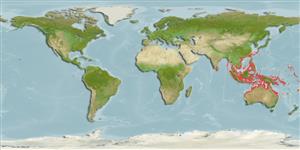Common names from other countries
Environment: milieu / climate zone / depth range / distribution range
Ökologie
seewasser riff-verbunden; tiefenbereich ? - 30 m (Ref. 58652), usually 1 - 30 m (Ref. 27115). Tropical; 30°N - 30°S
Western Pacific: Ryukyu Islands, the Philippines, and the North West Shelf, Western Australia.
Size / Gewicht / Alter
Maturity: Lm ? range ? - ? cm
Max length : 20.0 cm SL Männchen/unbestimmt; (Ref. 1419)
Rückenflossenstacheln (insgesamt): 13; Rückenflossenweichstrahlen (insgesamt): 10; Afterflossenstacheln 7; Afterflossenweichstrahlen: 9; Wirbelzahl: 13. Color the same as in S. vulpinus except for the blackish spot posteriorly on the upper side of the body. Caudal peduncle only slightly incised. Spines stout, pungent, and venomous. Preopercular angle 109°-119°. Variable cheek squamation; usually covered with scales, 7-10 rows deep below center of orbit, occasionally a few scattered scales present below eye; a triangular area from lower edge of orbit to angle of mouth always fully scaled. Fully scaled midline of thorax.
Inhabits rich coral areas of lagoons and outer reefs, often among staghorn corals (Ref. 90102). Small juveniles occur in schools of up to a few hundred fish, larger juveniles and adults occur in pairs. Feeds on seaweeds (Ref. 9813).
Life cycle and mating behavior
Geschlechtsreife | Fortpflanzung | Ablaichen | Eier | Fecundity | Larven
Woodland, D.J., 1990. Revision of the fish family Siganidae with descriptions of two new species and comments on distribution and biology. Indo-Pac. Fish. (19):136 p. (Ref. 1419)
IUCN Rote Liste Status (Ref. 130435)
CITES (Ref. 128078)
Not Evaluated
Bedrohung für Menschen
Venomous
Nutzung durch Menschen
Fischereien: kommerziell; Aquarium: Kommerziell
Mehr Information
NamenSynonymeMetabolismusRäuberÖkotoxikologieFortpflanzungGeschlechtsreifeAblaichenFecundityEierEientwicklung
PartnerBilderStamps, Coins Misc.LauteCiguateraGeschwindigkeitSchwimmstilKiemenoberflächeOtolithsGehirngrößeSehfähigkeit
Tools
Zusatzinformationen
Download XML
Internet Quellen
Estimates based on models
Preferred temperature (Ref.
115969): 25.4 - 29.1, mean 28.2 (based on 1226 cells).
Phylogenetic diversity index (Ref.
82804): PD
50 = 0.5000 [Uniqueness, from 0.5 = low to 2.0 = high].
Bayesian length-weight: a=0.01445 (0.00650 - 0.03213), b=3.08 (2.90 - 3.26), in cm Total Length, based on LWR estimates for this Genus-body shape (Ref.
93245).
Trophic level (Ref.
69278): 2.7 ±0.30 se; based on food items.
Widerstandsfähigkeit (Ref.
120179): hoch, Verdopplung der Population dauert weniger als 15 Monate. (Preliminary K or Fecundity.).
Fishing Vulnerability (Ref.
59153): Low vulnerability (14 of 100).
